Abstract
BACKGROUND: Previous studies have not resolved the importance of several potential risk factors for the development of childhood atopy, airway hyperresponsiveness, and wheezing, which would allow the rational selection of interventions to reduce morbidity from asthma. Risk factors for these disorders were examined in a birth cohort of 1037 New Zealand children. METHODS: Responses to questions on respiratory symptoms and measurements of lung function and airway responsiveness were obtained every two to three years throughout childhood and adolescence, with over 85% cohort retention at age 18 years. Atopy was determined by skin prick tests at age 13 years. Relations between parental and neonatal factors, the development of atopy, and features of asthma were determined by comparison of proportions and logistic regression. RESULTS: Male sex was a significant independent predictor for atopy, airway hyper-responsiveness, hay fever, and asthma. A positive family history, especially maternal, of asthma strongly predicted childhood atopy, airway hyperresponsiveness, asthma, and hay fever. Maternal smoking in the last trimester was correlated with the onset of childhood asthma by the age of 1 year. Birth in the winter season increased the risk of sensitisation to cats. Among those with a parental history of asthma or hay fever, birth in autumn and winter also increased the risk of sensitisation to house dust mites. The number of siblings, position in the family, socioeconomic status, and birth weight were not consistently predictive of any characteristic of asthma. CONCLUSIONS: Male sex, parental atopy, and maternal smoking during pregnancy are risk factors for asthma in young children. Children born in winter exhibit a greater prevalence of sensitisation to cats and house dust mites. These data suggest possible areas for intervention in children at risk because of parental atopy.
Full text
PDF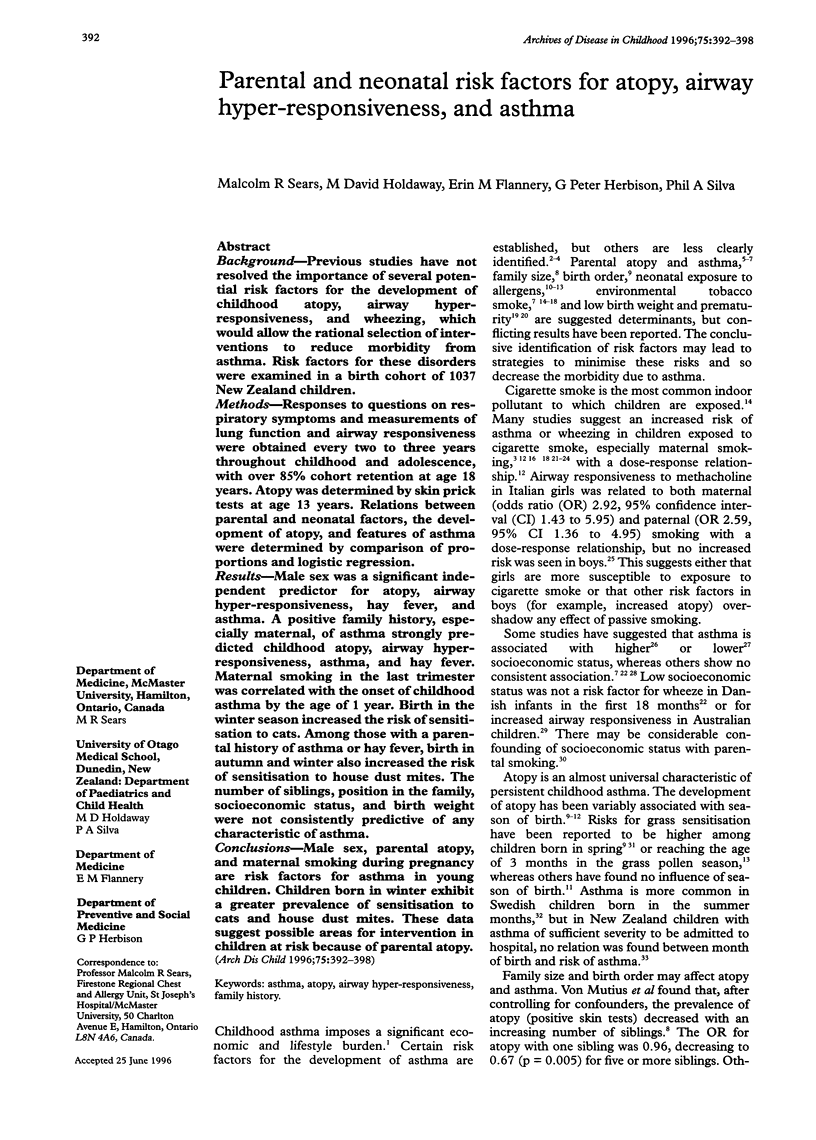
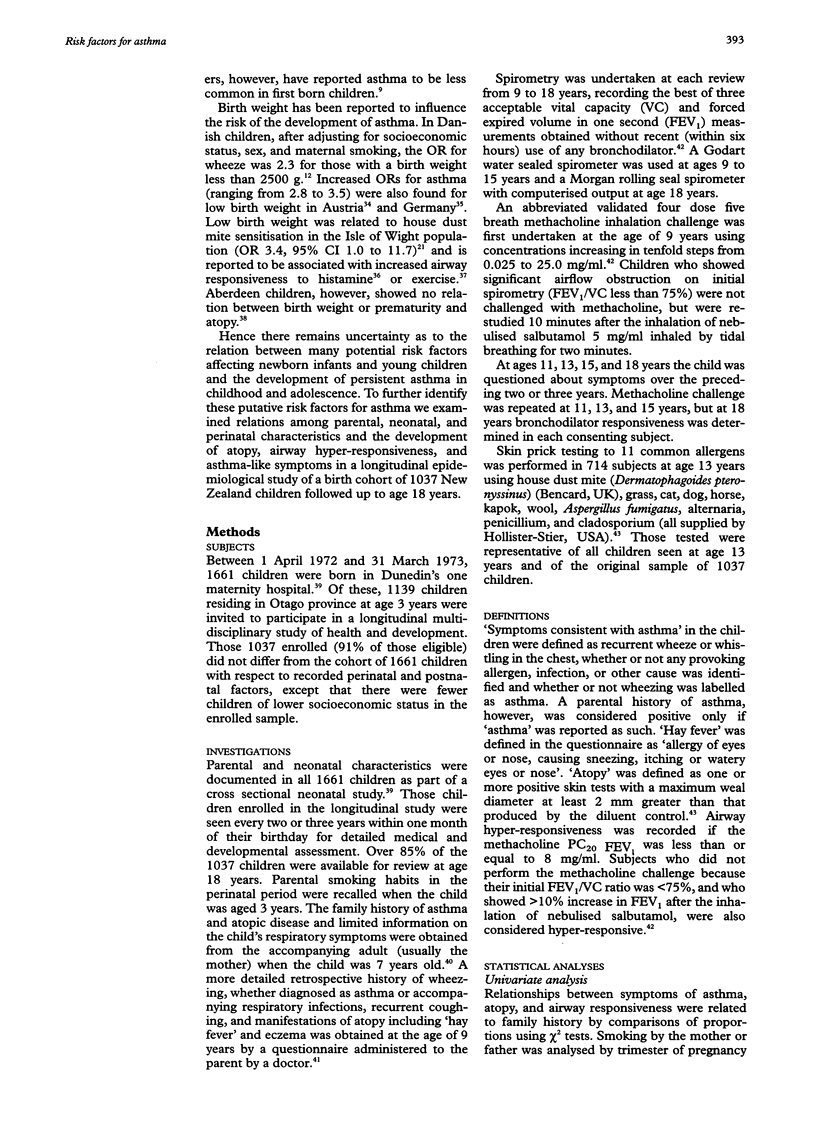
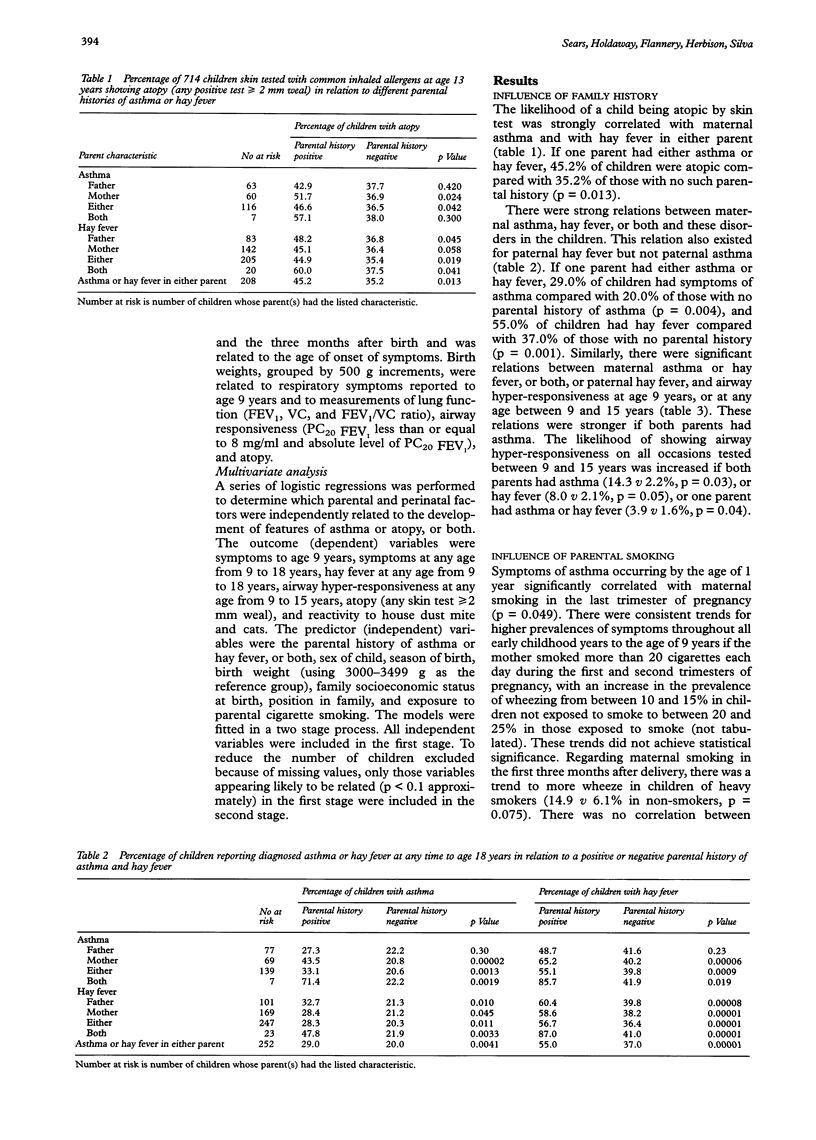
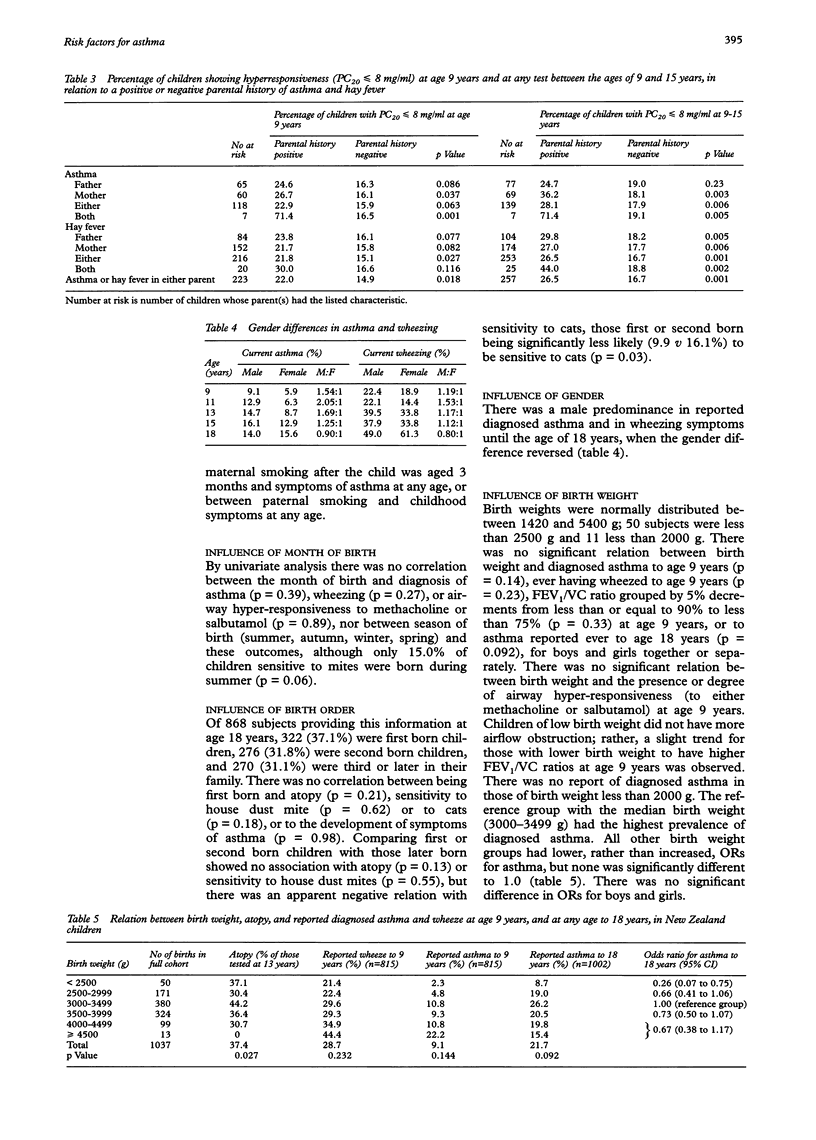
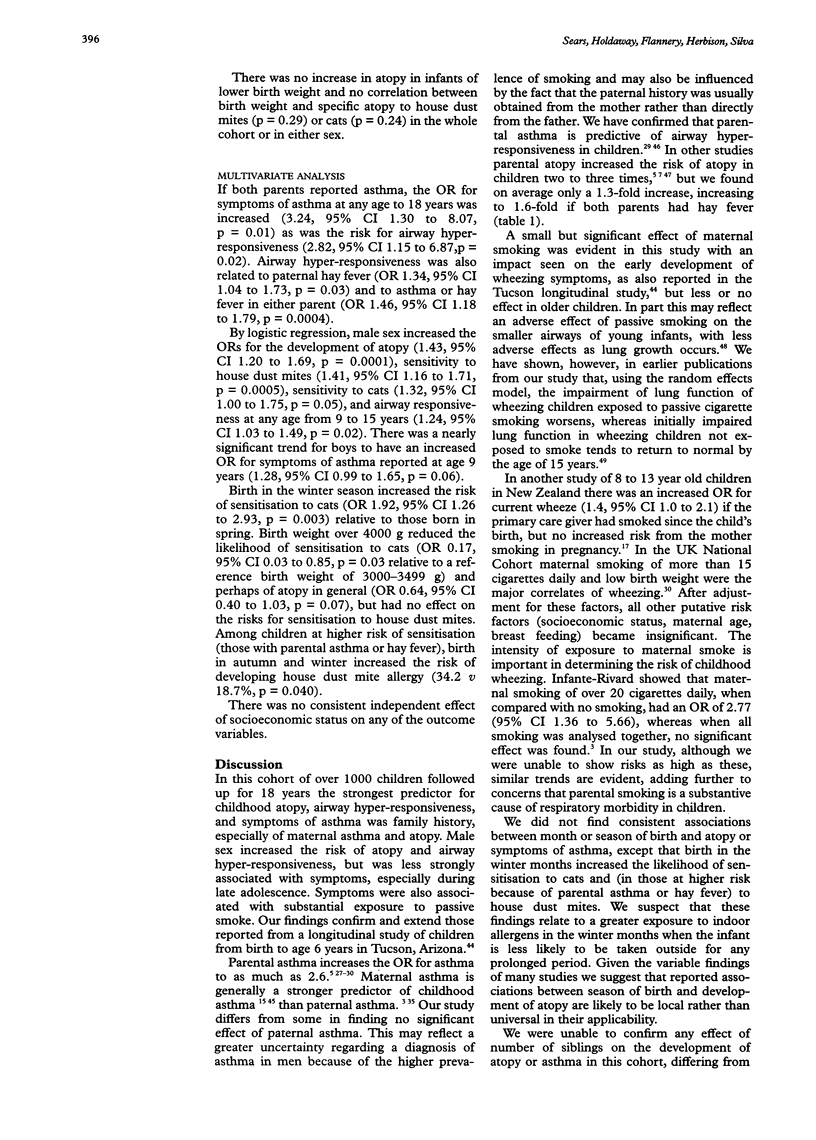
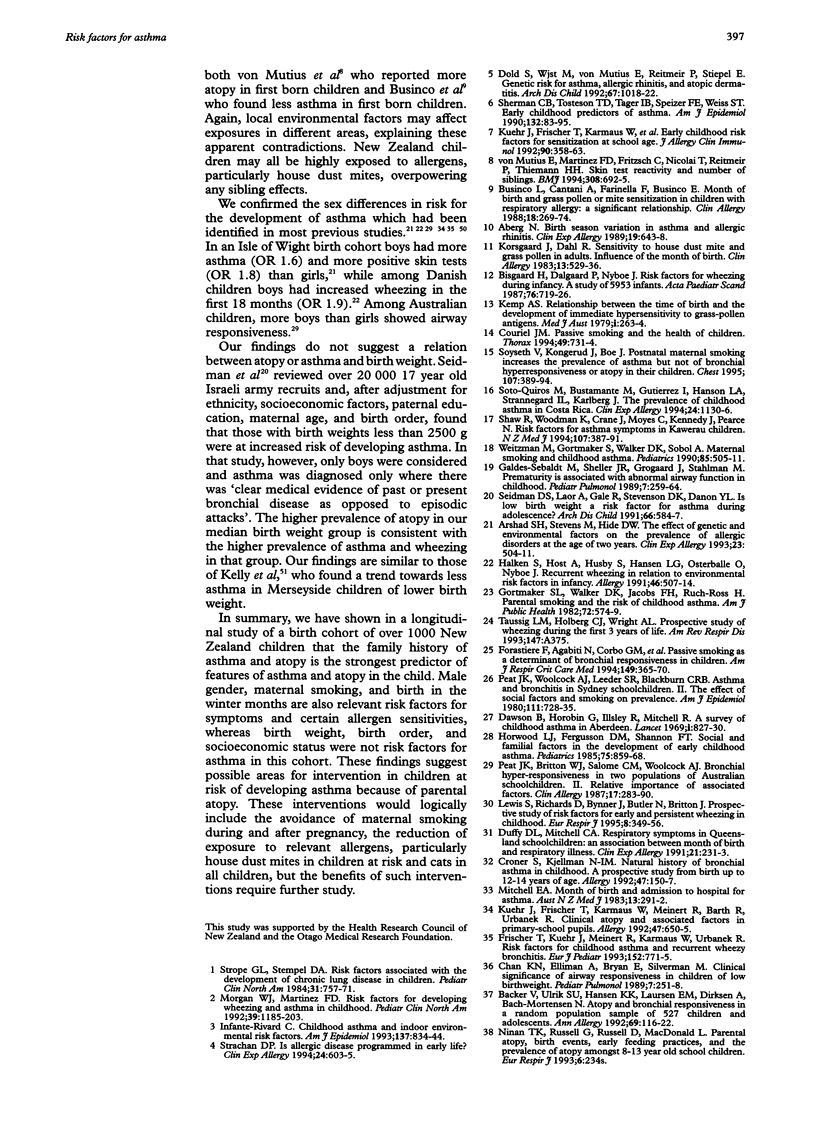
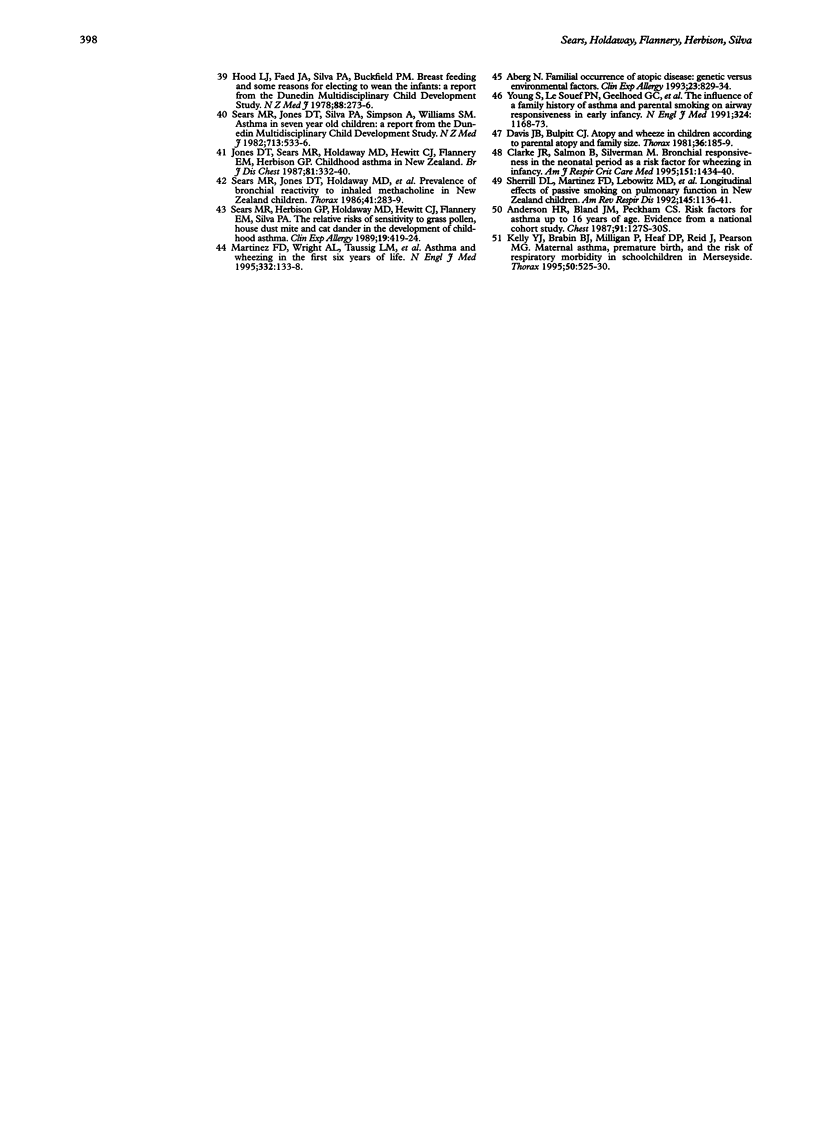
Selected References
These references are in PubMed. This may not be the complete list of references from this article.
- Aberg N. Birth season variation in asthma and allergic rhinitis. Clin Exp Allergy. 1989 Nov;19(6):643–648. doi: 10.1111/j.1365-2222.1989.tb02761.x. [DOI] [PubMed] [Google Scholar]
- Anderson H. R., Bland J. M., Peckham C. S. Risk factors for asthma up to 16 years of age. Evidence from a national cohort study. Chest. 1987 Jun;91(6 Suppl):127S–130S. doi: 10.1378/chest.91.6_supplement.127s. [DOI] [PubMed] [Google Scholar]
- Arshad S. H., Stevens M., Hide D. W. The effect of genetic and environmental factors on the prevalence of allergic disorders at the age of two years. Clin Exp Allergy. 1993 Jun;23(6):504–511. doi: 10.1111/j.1365-2222.1993.tb03238.x. [DOI] [PubMed] [Google Scholar]
- Backer V., Ulrik C. S., Hansen K. K., Laursen E. M., Dirksen A., Bach-Mortensen N. Atopy and bronchial responsiveness in random population sample of 527 children and adolescents. Ann Allergy. 1992 Aug;69(2):116–122. [PubMed] [Google Scholar]
- Bisgaard H., Dalgaard P., Nyboe J. Risk factors for wheezing during infancy. A study of 5,953 infants. Acta Paediatr Scand. 1987 Sep;76(5):719–726. doi: 10.1111/j.1651-2227.1987.tb10555.x. [DOI] [PubMed] [Google Scholar]
- Businco L., Cantani A., Farinella F., Businco E. Month of birth and grass pollen or mite sensitization in children with respiratory allergy: a significant relationship. Clin Allergy. 1988 May;18(3):269–274. doi: 10.1111/j.1365-2222.1988.tb02869.x. [DOI] [PubMed] [Google Scholar]
- Chan K. N., Elliman A., Bryan E., Silverman M. Clinical significance of airway responsiveness in children of low birthweight. Pediatr Pulmonol. 1989;7(4):251–258. doi: 10.1002/ppul.1950070411. [DOI] [PubMed] [Google Scholar]
- Clarke J. R., Salmon B., Silverman M. Bronchial responsiveness in the neonatal period as a risk factor for wheezing in infancy. Am J Respir Crit Care Med. 1995 May;151(5):1434–1440. doi: 10.1164/ajrccm.151.5.7735597. [DOI] [PubMed] [Google Scholar]
- Couriel J. M. Passive smoking and the health of children. Thorax. 1994 Aug;49(8):731–734. doi: 10.1136/thx.49.8.731. [DOI] [PMC free article] [PubMed] [Google Scholar]
- Croner S., Kjellman N. I. Natural history of bronchial asthma in childhood. A prospective study from birth up to 12-14 years of age. Allergy. 1992 Apr;47(2 Pt 2):150–157. doi: 10.1111/j.1398-9995.1992.tb00956.x. [DOI] [PubMed] [Google Scholar]
- Davis J. B., Bulpitt C. J. Atopy and wheeze in children according to parental atopy and family size. Thorax. 1981 Mar;36(3):185–189. doi: 10.1136/thx.36.3.185. [DOI] [PMC free article] [PubMed] [Google Scholar]
- Dawson B., Illsley R., Horobin G., Mitchell R. A survey of childhood asthma in Aberdeen. Lancet. 1969 Apr 19;1(7599):827–830. doi: 10.1016/s0140-6736(69)92082-0. [DOI] [PubMed] [Google Scholar]
- Dold S., Wjst M., von Mutius E., Reitmeir P., Stiepel E. Genetic risk for asthma, allergic rhinitis, and atopic dermatitis. Arch Dis Child. 1992 Aug;67(8):1018–1022. doi: 10.1136/adc.67.8.1018. [DOI] [PMC free article] [PubMed] [Google Scholar]
- Duffy D. L., Mitchell C. A. Respiratory symptoms in Queensland schoolchildren: an association between month of birth and respiratory illness. Clin Exp Allergy. 1991 Mar;21(2):231–233. doi: 10.1111/j.1365-2222.1991.tb00835.x. [DOI] [PubMed] [Google Scholar]
- Forastiere F., Agabiti N., Corbo G. M., Pistelli R., Dell'Orco V., Ciappi G., Perucci C. A. Passive smoking as a determinant of bronchial responsiveness in children. Am J Respir Crit Care Med. 1994 Feb;149(2 Pt 1):365–370. doi: 10.1164/ajrccm.149.2.8306031. [DOI] [PubMed] [Google Scholar]
- Frischer T., Kuehr J., Meinert R., Karmaus W., Urbanek R. Risk factors for childhood asthma and recurrent wheezy bronchitis. Eur J Pediatr. 1993 Sep;152(9):771–775. doi: 10.1007/BF01954000. [DOI] [PubMed] [Google Scholar]
- Galdès-Sebaldt M., Sheller J. R., Grogaard J., Stahlman M. Prematurity is associated with abnormal airway function in childhood. Pediatr Pulmonol. 1989;7(4):259–264. doi: 10.1002/ppul.1950070412. [DOI] [PubMed] [Google Scholar]
- Gortmaker S. L., Walker D. K., Jacobs F. H., Ruch-Ross H. Parental smoking and the risk of childhood asthma. Am J Public Health. 1982 Jun;72(6):574–579. doi: 10.2105/ajph.72.6.574. [DOI] [PMC free article] [PubMed] [Google Scholar]
- Halken S., Høst A., Husby S., Hansen L. G., Osterballe O., Nyboe J. Recurrent wheezing in relation to environmental risk factors in infancy. A prospective study of 276 infants. Allergy. 1991 Oct;46(7):507–514. doi: 10.1111/j.1398-9995.1991.tb00613.x. [DOI] [PubMed] [Google Scholar]
- Hide D. W. Food allergy in children. Clin Exp Allergy. 1994 Jan;24(1):1–2. doi: 10.1111/j.1365-2222.1994.tb00907.x. [DOI] [PubMed] [Google Scholar]
- Hood L. J., Faed J. A., Silva P. A., Buckfield P. M. Breast feeding and some reasons for electing to wean the infant: a report from the Dunedin Multidisciplinary Child Development Study. N Z Med J. 1978 Oct 11;88(621):273–276. [PubMed] [Google Scholar]
- Horwood L. J., Fergusson D. M., Shannon F. T. Social and familial factors in the development of early childhood asthma. Pediatrics. 1985 May;75(5):859–868. [PubMed] [Google Scholar]
- Infante-Rivard C. Childhood asthma and indoor environmental risk factors. Am J Epidemiol. 1993 Apr 15;137(8):834–844. doi: 10.1093/oxfordjournals.aje.a116745. [DOI] [PubMed] [Google Scholar]
- Jones D. T., Sears M. R., Holdaway M. D., Hewitt C. J., Flannery E. M., Herbison G. P., Silva P. A. Childhood asthma in New Zealand. Br J Dis Chest. 1987 Oct;81(4):332–340. doi: 10.1016/0007-0971(87)90181-1. [DOI] [PubMed] [Google Scholar]
- Kelly Y. J., Brabin B. J., Milligan P., Heaf D. P., Reid J., Pearson M. G. Maternal asthma, premature birth, and the risk of respiratory morbidity in schoolchildren in Merseyside. Thorax. 1995 May;50(5):525–530. doi: 10.1136/thx.50.5.525. [DOI] [PMC free article] [PubMed] [Google Scholar]
- Kemp A. S. Relationship between the time of birth and the development of immediate hypersensitivity to grass-pollen antigens. Med J Aust. 1979 Apr 7;1(7):263–264. doi: 10.5694/j.1326-5377.1979.tb112072.x. [DOI] [PubMed] [Google Scholar]
- Korsgaard J., Dahl R. Sensitivity to house dust mite and grass pollen in adults. Influence of the month of birth. Clin Allergy. 1983 Nov;13(6):529–535. doi: 10.1111/j.1365-2222.1983.tb02634.x. [DOI] [PubMed] [Google Scholar]
- Kuehr J., Frischer T., Karmaus W., Meinert R., Barth R., Herrmann-Kunz E., Forster J., Urbanek R. Early childhood risk factors for sensitization at school age. J Allergy Clin Immunol. 1992 Sep;90(3 Pt 1):358–363. doi: 10.1016/s0091-6749(05)80015-6. [DOI] [PubMed] [Google Scholar]
- Kuehr J., Frischer T., Karmaus W., Meinert R., Barth R., Urbanek R. Clinical atopy and associated factors in primary-school pupils. Allergy. 1992 Dec;47(6):650–655. doi: 10.1111/j.1398-9995.1992.tb02390.x. [DOI] [PubMed] [Google Scholar]
- Lewis S., Richards D., Bynner J., Butler N., Britton J. Prospective study of risk factors for early and persistent wheezing in childhood. Eur Respir J. 1995 Mar;8(3):349–356. doi: 10.1183/09031936.95.08030349. [DOI] [PubMed] [Google Scholar]
- Mitchell E. A. Month of birth and admission to hospital for asthma. Aust N Z J Med. 1983 Jun;13(3):291–292. doi: 10.1111/j.1445-5994.1983.tb04663.x. [DOI] [PubMed] [Google Scholar]
- Morgan W. J., Martinez F. D. Risk factors for developing wheezing and asthma in childhood. Pediatr Clin North Am. 1992 Dec;39(6):1185–1203. doi: 10.1016/s0031-3955(16)38440-1. [DOI] [PubMed] [Google Scholar]
- Peat J. K., Britton W. J., Salome C. M., Woolcock A. J. Bronchial hyperresponsiveness in two populations of Australian schoolchildren. II. Relative importance of associated factors. Clin Allergy. 1987 Jul;17(4):283–290. doi: 10.1111/j.1365-2222.1987.tb02016.x. [DOI] [PubMed] [Google Scholar]
- Peat J. K., Woolcock A. J., Leeder S. R., Blackburn C. R. Asthma and bronchitis in Sydney schoolchildren. II. The effect of social factors and smoking on prevalence. Am J Epidemiol. 1980 Jun;111(6):728–735. doi: 10.1093/oxfordjournals.aje.a112951. [DOI] [PubMed] [Google Scholar]
- Sears M. R., Herbison G. P., Holdaway M. D., Hewitt C. J., Flannery E. M., Silva P. A. The relative risks of sensitivity to grass pollen, house dust mite and cat dander in the development of childhood asthma. Clin Exp Allergy. 1989 Jul;19(4):419–424. doi: 10.1111/j.1365-2222.1989.tb02408.x. [DOI] [PubMed] [Google Scholar]
- Sears M. R., Jones D. T., Holdaway M. D., Hewitt C. J., Flannery E. M., Herbison G. P., Silva P. A. Prevalence of bronchial reactivity to inhaled methacholine in New Zealand children. Thorax. 1986 Apr;41(4):283–289. doi: 10.1136/thx.41.4.283. [DOI] [PMC free article] [PubMed] [Google Scholar]
- Sears M. R., Jones D. T., Silva P. A., Simpson A., Williams S. M. Asthma in seven year old children: a report from the Dunedin Multidisciplinary Child Development Study. N Z Med J. 1982 Aug 11;95(713):533–536. [PubMed] [Google Scholar]
- Seidman D. S., Laor A., Gale R., Stevenson D. K., Danon Y. L. Is low birth weight a risk factor for asthma during adolescence? Arch Dis Child. 1991 May;66(5):584–587. doi: 10.1136/adc.66.5.584. [DOI] [PMC free article] [PubMed] [Google Scholar]
- Shaw R., Woodman K., Crane J., Moyes C., Kennedy J., Pearce N. Risk factors for asthma symptoms in Kawerau children. N Z Med J. 1994 Oct 12;107(987):387–391. [PubMed] [Google Scholar]
- Sherman C. B., Tosteson T. D., Tager I. B., Speizer F. E., Weiss S. T. Early childhood predictors of asthma. Am J Epidemiol. 1990 Jul;132(1):83–95. doi: 10.1093/oxfordjournals.aje.a115646. [DOI] [PubMed] [Google Scholar]
- Sherrill D. L., Martinez F. D., Lebowitz M. D., Holdaway M. D., Flannery E. M., Herbison G. P., Stanton W. R., Silva P. A., Sears M. R. Longitudinal effects of passive smoking on pulmonary function in New Zealand children. Am Rev Respir Dis. 1992 May;145(5):1136–1141. doi: 10.1164/ajrccm/145.5.1136. [DOI] [PubMed] [Google Scholar]
- Strachan D. P. Is allergic disease programmed in early life? Clin Exp Allergy. 1994 Jul;24(7):603–605. doi: 10.1111/j.1365-2222.1994.tb00961.x. [DOI] [PubMed] [Google Scholar]
- Strope G. L., Stempel D. A. Risk factors associated with the development of chronic lung disease in children. Pediatr Clin North Am. 1984 Aug;31(4):757–771. doi: 10.1016/s0031-3955(16)34643-0. [DOI] [PubMed] [Google Scholar]
- Søyseth V., Kongerud J., Boe J. Postnatal maternal smoking increases the prevalence of asthma but not of bronchial hyperresponsiveness or atopy in their children. Chest. 1995 Feb;107(2):389–394. doi: 10.1378/chest.107.2.389. [DOI] [PubMed] [Google Scholar]
- Weitzman M., Gortmaker S., Walker D. K., Sobol A. Maternal smoking and childhood asthma. Pediatrics. 1990 Apr;85(4):505–511. [PubMed] [Google Scholar]
- Young S., Le Souëf P. N., Geelhoed G. C., Stick S. M., Turner K. J., Landau L. I. The influence of a family history of asthma and parental smoking on airway responsiveness in early infancy. N Engl J Med. 1991 Apr 25;324(17):1168–1173. doi: 10.1056/NEJM199104253241704. [DOI] [PubMed] [Google Scholar]
- von Mutius E., Martinez F. D., Fritzsch C., Nicolai T., Reitmeir P., Thiemann H. H. Skin test reactivity and number of siblings. BMJ. 1994 Mar 12;308(6930):692–695. doi: 10.1136/bmj.308.6930.692. [DOI] [PMC free article] [PubMed] [Google Scholar]


